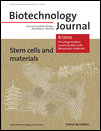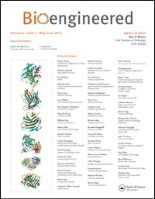
NATURE BIOTECHNOLOGY
Scope & Guideline
Transforming Ideas into Impactful Solutions
Introduction
Aims and Scopes
- Genome Editing and Engineering:
A central theme in the journal is the exploration and advancement of genome editing technologies, particularly CRISPR and its derivatives. This includes the development of novel editing systems that enhance specificity and reduce off-target effects. - Synthetic Biology:
Nature Biotechnology publishes studies on synthetic biology, which involves designing and constructing new biological parts, devices, and systems. This encompasses the engineering of microbes for applications in medicine, agriculture, and environmental sustainability. - Biotherapeutics and Drug Development:
The journal frequently features research on the development of biotherapeutics, including monoclonal antibodies, CAR-T therapies, and RNA-based therapeutics. This area focuses on the translation of basic research into clinical applications. - Bioinformatics and Computational Biology:
Computational approaches to analyzing biological data are a major focus, with studies leveraging machine learning, deep learning, and other computational tools to interpret complex biological datasets. - Microbiome Research:
Research on the microbiome and its implications for health and disease is increasingly prominent, reflecting a growing interest in understanding host-microbe interactions and their therapeutic potential. - Regenerative Medicine and Stem Cell Technology:
The journal covers advancements in regenerative medicine, including the use of stem cells for tissue engineering and the development of new therapies for degenerative diseases.
Trending and Emerging
- Advanced Genome Editing Techniques:
Newly developed genome editing tools, such as prime editing and base editing, are gaining traction. These methods promise greater precision and fewer off-target effects, driving interest in their applications across various fields. - Integration of AI in Biotechnology:
The application of artificial intelligence and machine learning in biotechnology is rapidly expanding. Researchers are leveraging these technologies for predictive modeling, data analysis, and optimizing biotechnological processes. - Personalized Medicine:
Research focused on personalized medicine, particularly in the context of cancer and rare diseases, is on the rise. This trend is driven by advancements in genomics and an increasing emphasis on tailored therapeutic approaches. - Sustainability and Environmental Biotechnology:
There is an emerging focus on biotechnological solutions aimed at addressing environmental challenges, such as bioremediation and sustainable agricultural practices, reflecting a broader societal push towards sustainability. - Cell and Gene Therapies:
The field of cell and gene therapies is rapidly advancing, with increasing numbers of studies exploring novel therapies and delivery methods, particularly in the context of genetic disorders and cancer treatment.
Declining or Waning
- Traditional Drug Discovery Methods:
As biotechnology evolves, traditional methods of drug discovery, which rely heavily on high-throughput screening of small molecules, are becoming less prominent. The focus has shifted towards more innovative approaches, such as utilizing AI and machine learning for drug development. - Plant Biotechnology:
Although still relevant, the frequency of publications specifically focused on plant biotechnology has decreased as the field expands into more integrated approaches combining multiple disciplines such as synthetic biology and gene editing. - Animal Models in Drug Testing:
There appears to be a decline in studies centered around traditional animal models for drug testing, as researchers increasingly explore alternative methods, including organoids and in vitro systems that better mimic human physiology. - Single-Cell Genomics:
While single-cell genomics remains important, there is a noticeable shift towards more integrative approaches that combine single-cell data with spatial transcriptomics and proteomics, indicating a transition away from isolated single-cell studies.
Similar Journals

BIOTECHNOLOGY LETTERS
Exploring the Cutting Edge of Biotechnological AdvancementsBIOTECHNOLOGY LETTERS is a prestigious peer-reviewed journal that has been at the forefront of biotechnology research since its inception in 1979. Published by Springer, this esteemed journal serves as a vital platform for disseminating cutting-edge research in the fields of applied microbiology, bioengineering, and biotechnology, with a focus on innovative methodologies and technologies. With an impact factor reflecting its critical contribution to the discipline, BIOTECHNOLOGY LETTERS resides in the Q2 and Q3 tiers of various scientific categories, placing it among the notable journals in the biotechnological landscape. Although it offers traditional access options and does not feature open access, the journal embraces a global readership, encouraging submissions from researchers, professionals, and students eager to explore the dynamic advancements in biotechnology. Situated in the Netherlands, it continues to shape the future of the field through relevant, impactful research that addresses contemporary challenges and opportunities in medicine and beyond.

Biotechnology Journal
Advancing the frontiers of biotechnological innovation.Biotechnology Journal, published by WILEY-V C H VERLAG GMBH, stands at the forefront of biotechnological research and innovation, recognized for its significant contributions to the fields of applied microbiology, molecular medicine, and broader biotechnology. With its ISSN 1860-6768 and E-ISSN 1860-7314, this journal has achieved impressive 2023 quartile rankings, positioning itself in Q1 for both Applied Microbiology and Biotechnology and Medicine (miscellaneous), and Q2 in Molecular Medicine, showcasing its impact and relevance within the scientific community. Based in Germany, the journal aims to disseminate high-quality research that drives advancements in biotechnological applications, fostering a platform for researchers, professionals, and students to engage with cutting-edge developments. With its ongoing commitment to excellence, the Biotechnology Journal is an essential resource for those seeking to stay informed about the latest trends and innovations in biotechnology.

Journal of Stem Cells & Regenerative Medicine
Exploring the Frontiers of Stem Cell ScienceThe Journal of Stem Cells & Regenerative Medicine is a leading publication dedicated to the advancing field of stem cell research and regenerative medicine. Established in India and published by JOURNAL STEM CELLS & REGENERATIVE MEDICINE, this Open Access journal has been available since 2007, providing researchers and practitioners with free and unrestricted access to high-quality articles. With an ISSN of 0973-7154, the journal is indexed in Scopus, featuring a wide array of topics and insights into biochemistry, biotechnology, cell biology, and molecular biology, as denoted by its relevant quartile rankings. This journal is committed to bridging the gap between laboratory research and clinical applications, making significant contributions to the scientific community. The convergence of innovative studies from 2010 to 2024 positions it as an invaluable resource for those looking to stay at the forefront of stem cell and regenerative medicine research.

MOLECULAR BIOTECHNOLOGY
Bridging Molecular Biology and Technological BreakthroughsMOLECULAR BIOTECHNOLOGY, published by SPRINGERNATURE, is a pivotal journal in the fields of applied microbiology, molecular biology, biochemistry, and biotechnology. Since its inception in 1994, the journal has aimed to disseminate high-quality research that explores the intersection of molecular biology and technology, fostering advancements in biotechnology applications. With an ISSN of 1073-6085 and an E-ISSN of 1559-0305, it has established itself as a significant contributor to the scientific community, currently holding a Q3 ranking across multiple categories including Applied Microbiology & Biotechnology and Biochemistry in the 2023 metrics. Although not an open access publication, the journal remains accessible through various institutional subscriptions, providing valuable insights and findings to researchers and professionals. Given its ongoing commitment to quality and relevance, MOLECULAR BIOTECHNOLOGY serves as an essential resource for those involved in cutting-edge research and innovation in molecular biotechnology and related disciplines.

Bioengineering-Basel
Driving Excellence in Bioengineering ResearchBioengineering-Basel, an esteemed journal published by MDPI, stands at the forefront of innovation in the field of bioengineering since its inception in 2014. With an E-ISSN of 2306-5354, this fully Open Access journal based in Switzerland provides a platform for researchers and professionals to disseminate cutting-edge findings across various aspects of bioengineering, including biomaterials, tissue engineering, and biopharmaceuticals. The journal has been recognized with a Q3 ranking in the 2023 Bioengineering category, reflecting its commitment to quality and relevance. By facilitating widespread accessibility to academic knowledge, Bioengineering-Basel aims to foster collaboration and stimulate thought leadership within the global research community, making it an indispensable resource for students, scholars, and industry practitioners alike.

BIOTECHNOLOGY ADVANCES
Transforming Knowledge into Biotechnological AdvancesBIOTECHNOLOGY ADVANCES is a premier, peer-reviewed journal published by PERGAMON-ELSEVIER SCIENCE LTD, dedicated to advancing knowledge in the rapidly evolving fields of biotechnology and bioengineering. With an ISSN of 0734-9750 and an E-ISSN of 1873-1899, this esteemed journal covers a wide spectrum of topics relevant to applied microbiology, molecular biology, and biochemical innovation. Recognized for its academic rigor, it holds a distinguished position in the top quartile (Q1) in multiple categories, including Applied Microbiology and Biotechnology, Bioengineering, and Biotechnology, further evidenced by its high rankings in Scopus, where it ranks #3/127 in Applied Microbiology and Biotechnology and #7/311 in Biotechnology. Researchers and professionals in the field value the journal not only for its comprehensive coverage of cutting-edge research but also for its commitment to disseminating critical findings and fostering collaboration. While BIOTECHNOLOGY ADVANCES currently operates under a subscription model, its potential impact on future innovations in biotechnology cannot be overstated, making it an essential resource for anyone interested in the forefront of biotechnological advancements.

Bioengineered
Advancing Interdisciplinary Discoveries in BioengineeringBioengineered, published by TAYLOR & FRANCIS INC, is an esteemed Open Access journal that has been at the forefront of research in the fields of bioengineering, biotechnology, and applied microbiology since its inception in 2012. With an impressive impact factor reflecting its high-quality contributions, the journal is categorized in the top quartiles, achieving Q1 rankings in Applied Microbiology and Biotechnology, as well as in Biotechnology and Medicine (Miscellaneous) for 2023. This active engagement in showcasing pioneering research is critical for professionals and students alike, facilitating access to revolutionary studies and methodologies. The journal operates under an Open Access model since 2018, ensuring that groundbreaking findings in bioengineering are readily accessible to a global audience. Situated in the United Kingdom, Bioengineered not only serves as a platform for innovative research but also underscores the importance of interdisciplinary collaborations among scientists, engineers, and biotechnologists.

TRENDS IN BIOTECHNOLOGY
Pioneering Research for a Biotechnological FutureTRENDS IN BIOTECHNOLOGY, published by CELL PRESS, stands as a premier journal since its inception in 1983, focusing on the dynamic and ever-evolving fields of bioengineering and biotechnology. With a notable impact factor and ranking in the top quartile (Q1) of its categories for 2023, this journal is recognized for its contribution to advancing scientific knowledge, boasting a Scopus rank of #5/311 in Biotechnology and #5/162 in Bioengineering, placing it in the 98th and 97th percentiles, respectively. Although it does not operate under an open access model, TRENDS IN BIOTECHNOLOGY ensures a rigorous peer-review process that provides a platform for high-quality research that influences both academic and industrial advancements. The journal's objectives encompass the dissemination of cutting-edge research findings, reviews, and insights that foster innovation in biotechnological applications, making it an invaluable resource for researchers, professionals, and students alike. With its broad scope across the intersection of biosciences and technology, TRENDS IN BIOTECHNOLOGY continues to lead discussions and developments that shape the future of the biotechnology landscape.

AIMS Bioengineering
Fostering Innovations for a Healthier TomorrowAIMS Bioengineering, published by the American Institute of Mathematical Sciences (AIMS), is an esteemed open-access journal dedicated to advancing knowledge in the interdisciplinary field of bioengineering. With the ISSN 2375-1495, this journal has been providing a platform for the rapid dissemination of high-quality research since its establishment in 2014. AIMS Bioengineering covers a wide range of topics, including but not limited to, biomaterials, computational biology, and bioinformatics, making it an essential resource for researchers, professionals, and students alike. Although the H-index and specific category quartiles are not currently available, the journal's commitment to open access ensures that cutting-edge findings are accessible to a global audience, fostering collaboration and innovation in bioengineering. With its rigorous peer-review process and dedication to scholarly excellence, AIMS Bioengineering continues to play a pivotal role in shaping the future of the bioengineering landscape.

International Journal of Stem Cells
Pioneering Discoveries in Developmental BiologyThe International Journal of Stem Cells is a distinguished peer-reviewed journal dedicated to advancing the field of stem cell research. Published by the Korean Society for Stem Cell Research, this journal has established itself as a vital source of high-quality research since its inception in 2008. Operating under the ISSN 2005-3606 and E-ISSN 2005-5447, the journal caters to a global audience, featuring works that span a diverse array of topics within Cell Biology and Developmental Biology. It is noteworthy that as of 2023, the journal is ranked Q3 in Cell Biology and Q2 in Developmental Biology, highlighting its growing influence and credibility in the scientific community. Given its commitment to facilitating open scientific communication, it is crucial for researchers, professionals, and students to engage with the rigorous research published in this journal as it profoundly impacts the understanding and application of stem cell science. With accessibility to a wealth of innovative studies, the International Journal of Stem Cells remains an indispensable resource for anyone interested in the transformative potential of stem cell research.